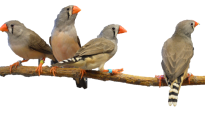Personality and Pair Bonds

By Lisa Barrett
Most people now recognize that their pets have notable personalities, and you probably know a timid, aggressive, or social dog or cat. But behavioral ecologists have been studying individual behavioral variation for some time. What once was deemed to be “statistical noise” or the result of inaccurate measurements, individual behavioral type, or personality, is now one of the most popular topics within animal behavior, biology, and behavioral ecology. It is fascinating to consider that, like humans, non-human animals possess consistent (across time or context) behavioral differences between individuals within the same species. And some personalities may confer greater advantages than others in certain contexts or situations. We can measure personality in animals by presenting them with novel objects and measuring their approach time, or by observing how social or aggressive they are toward other individuals in their group. I am excited to investigate these ideas in Asian elephants and zebra finches as part of my Ph.D. dissertation project at the University of Wyoming. Since I’ve dedicated several blogs to elephants, let’s discuss a bit more about why zebra finches are an interesting study species in which to pursue questions about personality.

To assess personality traits, scientists can measure an animal’s response toward novel objects, like this pink panther toy.
Zebra finches (Taeniopygia guttata) are native to Australia, and they are monogamous, meaning that they usually mate and breed with only one individual for life. Female zebra finches choose who they will mate with, and together, these individuals form a pair bond—or courtship and mating relationship—for life. Since not all female zebra finches agree on who is the best male with which to mate, researchers are intrigued by the traits on which females base their choice. And I am interested in how the strength of a relationship between these pair members—and how the personality combinations of the individuals forming the pair—can affect performance on problem-solving tasks. Although zebra finches are well-studied in laboratory settings, we lack an understanding about how personality influences mate selection in this species.
Various research suggests there may be a benefit to having a mate with a similar or dissimilar personality to your own. The personality an individual exhibits could therefore reflect the individual’s quality as a potential mate by, for example, indicating its ability to gain resources or its willingness to commit parental investment. Perhaps, then, female zebra finches assess behavioral compatibility in potential mates. And, in addition to assessing overall mate quality, a female might also gauge which male is most compatible for her given her own personality type.
There is evidence that parents with similar personalities raise offspring with higher fitness as compared to offspring of parents with dissimilar personalities. Cockatiel pairs with higher behavioral compatibility scores (more affiliation and less aggression compared to that of other pairs) also had greater coordination in incubating their eggs. Perhaps an incompatible pair could therefore suffer from reduced efficiency in supplying food to their young or reduced offspring survival, because parents are not coordinated or do not maximize their efficiency in their parental care.
Alternatively, it may be costly to have a mate with a similar personality. For example, there may be a speed-accuracy tradeoff in foraging efficiency, in which a fast-type individual quickly searches for seed but is not very precise in locating seed, and a slow-type individual continuously and slowly re-samples the environment and is better able to detect seed. Slower-type individuals may be better at reversal learning tasks in which they must learn an opposite rule of the one to which they were previously exposed; this suggests that it could be beneficial for a bird to include this behavioral type in its pair. Pairs with mates of the same personality may be at a disadvantage, since both parents’ personalities may only be beneficial in one context. When dealing with complex environments or foraging challenges, it may be beneficial for individuals to choose a mate with an opposite personality type to their own. Additionally, some work suggests that a female may choose a mate based on her own quality; perhaps this preference is exemplified by her personality and the personality of her chosen mate.
Despite substantial research on zebra finches, we lack an understanding about pair coordination across different personality combinations. This could have important implications in understanding mate choice in the animal kingdom. As part of my dissertation research on personality and problem-solving ability in elephants and zebra finches, I plan to address this gap in our knowledge. I’m excited to share my results with you!
References
Chittka, L., Skorupski, P., & Raine, N. E. (2009). Speed-accuracy tradeoffs in animal decision making. Trends in Ecology and Evolution, 24(7), 400–407.
Guillette, L. M., Reddon, A. R., Hoeschele, M., & Sturdy, C. B. (2011). Sometimes slower is better: slow-exploring birds are more sensitive to changes in a vocal discrimination task. Proc. R. Soc. B, 278(1706), 767–773.
Ihle, M., Kempenaers, B., & Forstmeier, W. (2015). Fitness benefits of mate choice for compatibility in a socially monogamous species. PLoS Biology, 13(9), 1–22.
Schuett, W., Dall, S. R. X., & Royle, N. J. (2011). Pairs of zebra finches with similar “personalities” make better parents. Animal Behaviour, 81(3), 609–618.
van Rooij, E. P., & Griffith, S. C. (2013). Synchronised provisioning at the nest: parental coordination over care in a socially monogamous species. PeerJ, 1, e232.





Very interesting!!
Thank you, @tarnegolita !
Very interesting article. I haven’t read much before about zebra finches. This was educational.
Thank you, Kelly!
Pingback: Summer Research in San Diego | DANTAisms
Pingback: National Geographic dissertation research feature | DANTAisms